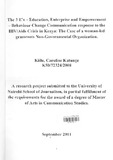| dc.description.abstract | According to Shisanya, 2008, the five measures currently being promoted in Kenya, for awareness of HIV/AIDS prevention measures and patterns are:
1) The use of condoms;
2) Screening for HIV at Voluntary Counseling and Testing (VCT) Centers;
3) Prevention of mother-to-child transmission (PMTCT);
4) The use of post-exposure prophylaxis (PEP); and
5) The prompt treatment for sexually transmitted infections (STIs).
The core problem facing Kenya today, related to poverty, disease and lack of development, is the exclusion of a large population from accessing means and engaging decisions that would transform their lives. This void is what led to the 3Es. These are Education, Enterprise and Empowerment. 'Lack of the 3 Es generally leads to exclusion from the process of empowerment' (Ringera, personal communication, September, 2010). Specifically, however, lack of education disenfranchises an individual overall, and among other things, leads to lack of employment opportunities.
This then renders the individual unable to meet their basic needs. This inability subsequently leads to lack of empowerment. Empowerment refers to an individual's ability to take control of their life and attain self-reliance. Kenya is a low-income country, with approximately 80 per cent of its 38.6 million people living in rural areas, subsidizing on agricultural production. The HIV / Aids pandemic has deepened poverty among the already impoverished. This research examined the workings of International Peace Initiatives _ Kenya (IPI-K) in relation to applying the 3Es as an effective and sustainable Behaviour Change Communication model, in response to mitigating the effects of HIV/AIDS in rural Kenya.
This study concludes that knowledge of a community's economic activities as well as their accessibility coupled with knowledge especially of women is paramount, to those planning HIV/AIDS interventions. If HIV/AIDS interventions do not take cognizance of the fact that a community needs to be educated and facilitated to engage in income generating activities, then the empowerment that is needed to reduce HIV infections as well as ensure those already infected live positively, cannot occur. Also directing HIV/AIDS BCC strategies to focus on prevention measures and strategies which target the married and elderly men, will enable them protect their spouses and allow a possible reversal of the current tragic trend, where marriage is actually heightening the risk of HIV infection. | en_US |

